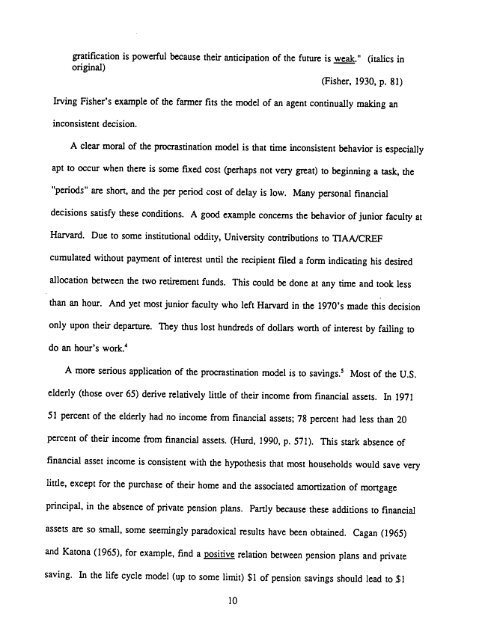INSTITUTE FOR
INSTITUTE FOR
INSTITUTE FOR
You also want an ePaper? Increase the reach of your titles
YUMPU automatically turns print PDFs into web optimized ePapers that Google loves.
gratification is powerful because their anticipation of the future is weak." (italics in<br />
original)<br />
(Fisher, 1930, p. 81)<br />
Irving Fisher's example of the farmer fits the model of an agent continually making an<br />
inconsistent decision.<br />
A clear moral of the procrastination model is that time inconsistent behavior is especially<br />
apt to occur when there is some fixed cost (perhaps not very great) to beginning a task, the<br />
"periods" are short, and the per period cost of delay is low. Many personal financial<br />
decisions satisfy these conditions. A good example concerns the behavior of junior faculty at<br />
Harvard. Due to some institutional oddity, University contributions to TIAA/CREF<br />
cumulated without payment of interest until the recipient filed a form indicating his desired<br />
allocation between the two retirement funds. This could be done at any time and took less<br />
than an hour. And yet most junior faculty who left Harvard in the 1970's made this decision<br />
only upon their departure. They thus lost hundreds of dollars worth of interest by failing to<br />
do an hour's work. 4<br />
A more serious application of the procrastination model is to savings. 5 Most of the U.S.<br />
elderly (those over 65) derive relatively little of their income from financial assets. In 1971<br />
51 percent of the elderly had no income from financial assets; 78 percent had less than 20<br />
percent of their income from financial assets. (Hurd, 1990, p. 571). This stark absence of<br />
financial asset income is consistent with the hypothesis that most households would save very<br />
little, except for the purchase of their home and the associated amortization of mortgage<br />
principal, in the absence of private pension plans. Partly because these additions to financial<br />
assets are so small, some seemingly paradoxical results have been obtained. Cagan (1965)<br />
and Katona (1965), for example, find a positive relation between pension plans and private<br />
saving. In the life cycle model (up to some limit) $1 of pension savings should lead to $1<br />
10

















